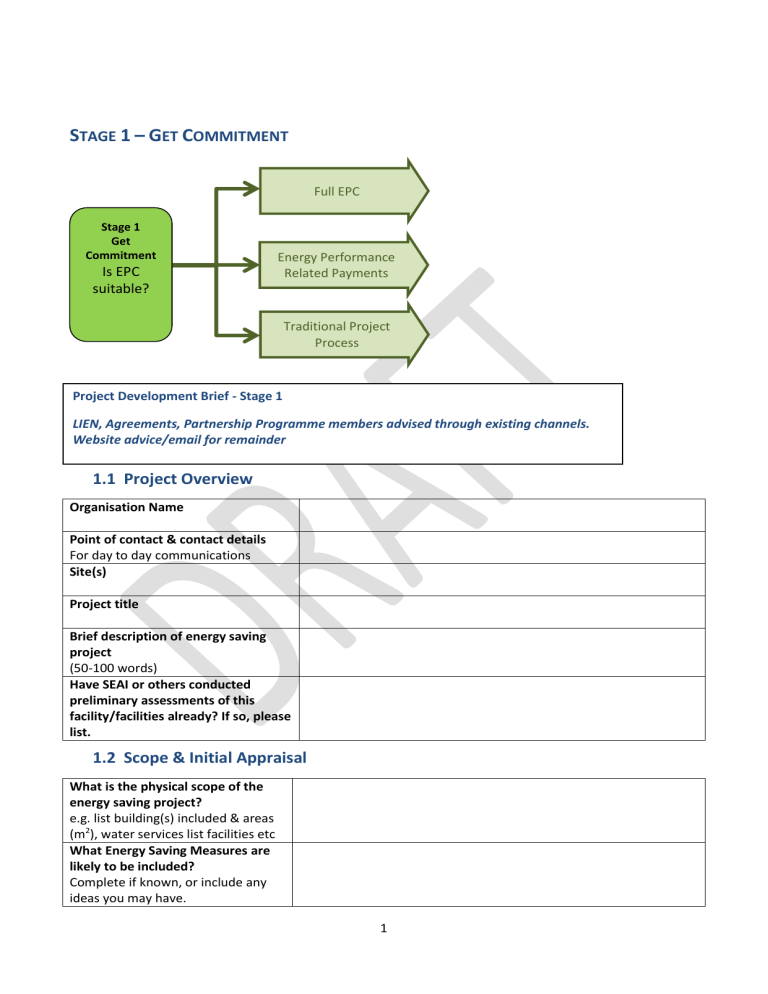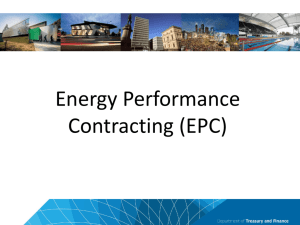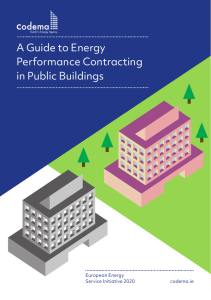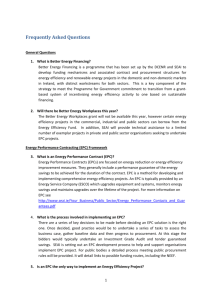Stage 1 – Get Commitment

S
TAGE
1 – G
ET
C
OMMITMENT
Stage 1
Get
Commitment
Is EPC suitable?
Full EPC
Energy Performance
Related Payments
Traditional Project
Process
Project Development Brief - Stage 1
LIEN, Agreements, Partnership Programme members advised through existing channels.
Website advice/email for remainder
1.1
Project Overview
Organisation Name
Point of contact & contact details
For day to day communications
Site(s)
Project title
Brief description of energy saving project
(50-100 words)
Have SEAI or others conducted preliminary assessments of this facility/facilities already? If so, please list.
1.2
Scope & Initial Appraisal
What is the physical scope of the energy saving project? e.g. list building(s) included & areas
(m 2 ), water services list facilities etc
What Energy Saving Measures are likely to be included?
Complete if known, or include any ideas you may have.
1
Project status
Delete as appropriate
Existing annual utility costs
Costs (€) and energy usage of the facility, or facilities, within the scope of this project.
Electricity
Gas
Others (specify):
(e.g. water if included in scope)
Non energy costs;
(Maintenance etc)
The above figures are:
Delete as appropriate
Projected annual savings
(see Note 1)
Cost (€) and quantity.
Electricity
Gas
Others (specify):
Non-energy savings:
(e.g. maintenance savings, fuel switching)
The above figures are:
Delete as appropriate a.
Concept b.
Progressing and gathering information c.
Ready to procure
Cost (ex. VAT) d.
Procurement e.
Competitive dialogue f.
Under construction/Complete g.
Other (please specify)
Quantity Units
(kWh, litres etc) a. Accurate b. Approximate, but based on some assessment c. Estimates / order of magnitude
Value (ex. VAT) Quantity Units
(kWh, litres etc)
Expected project cost (not including internal costs)
(see Note 1)
The above figures are:
Delete as appropriate
Simple (or real) payback in years
How do you envisage the project being financed?
Delete as appropriate
1.3
Objectives & Commitment
a. Accurate b. Approximate, but based on some assessment c. Estimates / order of magnitude a. Accurate b. Approximate, but based on some assessment c. Estimates / order of magnitude a. By organisation’s own funds / normal capital arrangements b. By ESCO c. By organisation accessing national Energy Efficiency Fund d. Other (please specify)
What are the objectives you expect the project will deliver a. Completely retrofitted facility/facilities, life cycle investment
(including retrofitting with no energy saving benefits) b. Total retrofit – all energy saving measures and non energy savings
2
Do you envisage this being:
Delete as appropriate
Identify special considerations, for example:
Organisational barriers that may need to be overcome?
Is there sufficient commitment to
progress the project further? c. Total retrofit – all energy saving measures retrofitted d. Partial retrofit – selected mix of technologies i.e. boilers and BMS e. Single technology energy saving project only, e.g. lighting or pumps a. An Energy Performance Contract (EPC) b. A Local Energy Supply Contract (LESC) c. A combination of a. and b. above d. A performance guarantee and payment incorporated into existing contracts e. To be decided f. Uncertain as to the difference between the options above a. Will there be a change of owner in the near future? b. Are there existing contractual arrangements in place (facilities management contracts, or similar energy contracting arrangements)? c. Are there existing maintenance or contracting arrangements in place that need to be considered? d. Other:
Please highlight those above that may require further investigation before deciding to go to procurement. a. Management are convinced of the energy contracting concept and want to move quickly b. Management are broadly aware of the energy contracting concept and are interested but need convincing c. Management have some experience of contracting services and maybe interested in the energy services contracting concept d. Management are reluctant to trial new approaches until proven and are not comfortable with contracting energy services a. Chief Executive Officer level committed b. Senior management sponsor committed c. Departmental management committed d. Energy champion committed d. All of the above
1.4
Attachments
Please include the following
For sites with multiple facilities, a simple site layout drawing with included areas marked ()
Historical energy and cost data: ideally 36 months for each energy type, but provide what is readily available rather than spending considerable time on this.
Other information you think relevant (please specify):
3
1.5
Stage Gate – Senior Management Commitment
At this point you should have an understanding of the likely scope of the project, its financial scale, and what you are trying to get the EPC to deliver.
Prior to committing additional management time and resources to following the EPC project development process, it is strongly recommended that it has the support of a senior manager.
Public Sector Supports
Support may be available from SEAI to assist qualifying Public Sector organisations through the process: contact your Partnership Support
Manager to discuss. To qualify for support, a statement of commitment is essential.
Statement of commitment
I have reviewed this document and am ready to commit my organisation and resources, including management time, to examining the potential for EPC and proceeding through the EPC development process.
Date Signed
Print name Position
4
Note 1: Project savings and budgetary costs
At this point some organisations may not have a clear project scope in mind, making it difficult to project savings and budgetary costs. An approach here is to identity what percentage savings the organisation wishes to achieve, quantify this in euro terms, multiply the answer by 7 to get a budgetary capital figure for a project with a 7 year simple payback. At stage 2 the organisation can seek to identify projects of suitable scope to deliver the desired savings and establish if the simple payback on these is sufficient.
Example:
Annual energy spend €1,000,000
Target annual savings 20% = €200,000
Budgetary investment = 7 x €200,000 = €1,400,000.
At this stage, stage 1, indicative or estimated figures are acceptable. You may wish to look at different scenarios. For example, if the payback/contract term were extended to 15 years, then €3,000,000 could be invested in the facility and repaid through the energy savings. This might enable you to do ‘deeper’ actions which typically have longer paybacks (e.g. windows, fabric retrofit, etc). Remember it is the average payback that broadly determines the term. Hence some contracts offer up all savings to an
ESCO, including no/low cost savings to subsidise longer payback measures. At this early project stage
(stage 1), it is broad organisation and financial objectives you are trying to define. These may and probably will change as you move through the Framework and your understanding deepens.
In this simple example, other costs such as project management, ESCO fees, servicing fees are excluded.
At stage 2, the next stage, of the Framework, the organisation can seek to identify projects of suitable scope to deliver the desired savings and establish if the simple payback on these is sufficient. It can also assess the total cost of the project, and investigate the ‘portfolio’ of measures required that meet their overall objectives and financial criteria.
5
6











